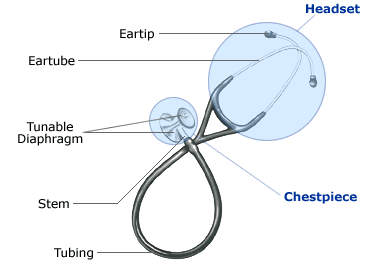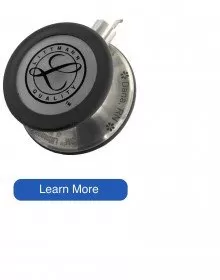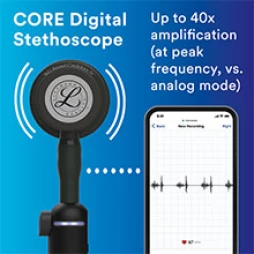1. What is the correct terminology for the parts of a stethoscope?
2. What type of stethoscope should I purchase?
3. Is there a difference in sound quality between long and short tubing?
4. How do I measure my tubing length?
5. What are the advantages of using a tunable diaphragm?
6. Do the stethoscopes sold on this website contain latex?
7. Why would I want to have a tunable diaphragm on a traditional two-sided stethoscope?
8. I can't hear anything out of my stethoscope. What is wrong with it?
1. What is the correct terminology for the parts of a stethoscope?
The below diagram illustrates the different parts of a stethoscope.

Headset: The headset is the metal part of the stethoscope onto which the tubing is fitted. The headset is made up of the two eartubes, tension springs and the eartips.
Chest Piece: The chest piece is the part of the stethoscope that is placed on the location where the user wants to hear sound. Most cardiology stethoscopes contain a tunable diaphragm on each side of the chest piece. The large side can be used for adult patients, while the small side especially useful for pediatric or thin patients, around bandages and for carotid assessment.
Eartip: The eartips of a stethoscope fit into your ears. A good stethoscope will have eartips that offer comfort, seal and durability.
Eartube: The eartube is the part to which the eartips are attached.
Tunable Diaphragm: A traditional stethoscope consists of a bell and diaphraghm. The bell is used for light skin contact to hear low frequency sounds and the diaphragm is used with firm skin contact to hear high frequency sounds.
Stem: The stemp connects the stethoscope tubing to the chestpiece.
Tubing: All stethoscopes sold on myStethoscope.com do not contain latex. 3M Littmann stethoscope.
2. What type of stethoscope should I purchase? Acoustic vs. Electronic
Acoustic Stethoscopes
Acoustic stethoscopes are familiar to most people, and operate on the transmission of sound from the chestpiece, via air-filled hollow tubes, to the listener's ears. The chestpiece usually consists of two sides that can be placed against the patient for sensing sound a diaphragm (plastic disc) or bell (hollow cup). If the diaphragm is placed on the patient, body sounds vibrate the diaphragm, creating acoustic pressure waves which travel up the tubing to the listener's ears. If the bell is placed on the patient, the vibrations of the skin directly produce acoustic pressure waves traveling up to the listener's ears. The bell transmits low frequency sounds, while the diaphragm transmits higher frequency sounds. Acoustic stethoscopes are the most commonly used.
Electronic Stethoscopes
Electronic stethoscopes overcome the low sound levels by amplifiying body sounds. Electronic stethoscopes require conversion of acoustic sound waves to electrical signals which can then be amplified and processed for optimal listening.
More recently, ambient noise filtering has become available in electronic stethoscopes, with 3M's Littmann 3000 and Thinklabs ds32a offering methods for eliminating ambient noise.
Some electronic stethoscopes feature direct audio output that can be used with an external recording device, such as a laptop or MP3 recorder. The same connection can be used to listen to the previously-recorded auscultation through the stethoscope headphones, allowing for more detailed study for general research as well as evaluation and consultation regarding a particular patient's condition and telemedicine, or remote diagnosis.
3. Is there a difference in sound quality between long and short tubing?
Past publications have suggested that the shorter the tubing, the better the acoustic response. Laboratory testing has shown this to be true, but the average hearing person will only pick up a difference if there is an extreme increase in tubing length. In fact, based on the manner in which sound waves travel, there is a slight advantage in low frequency sounds with longer tubing. Most heart sounds are considered to be in the lower frequency range. Length of tubing seems to be a personal preference, based on physique and infection control issues viewed by the user.
4. How do I measure my tubing length?
Tubing length is measured from the top of the eartips to the bottom of the chestpiece.
5. What are the advantages of using a tunable diaphragm?
When using a stethoscope with a tunable diaphragm, the user does not have to remove the chestpiece from the patient in order to change from the bell to diaphragm mode. Also, single-sided chestpieces are shaped to provide a more comfortable grip for better feel and control.
When listening to low frequency sounds with a tunable diaphragm as opposed to a bell, there will be an increase in amplitude, or loudness. This is because the sound is coming through a diaphragm with a larger surface area, as opposed to the smaller opening on a standard bell. The sound pressure level increases with an increase in contact area on the patient.
6. Do the stethoscopes sold on this website contain latex?
99% of the stethoscopes we sell, do not contain natural rubber latex or dry natural rubber as components or in the product or packaging. If a product contains latex, it will clearly state this in the product description.
7. Why would I want to have a tunable diaphragm on a traditional two-sided stethoscope?
A tunable diaphragm offers convenience and versatility. A tunable diaphragm on a two-sided stethoscope offers one the choice of using it as a traditional stethoscope, or using only the diaphragm side for both low and high frequency sounds.
8. I can't hear anything out of my stethoscope. What is wrong with it?
Optimizing the Acoustical Performance
Proper Headset Alignment: Littmann stethoscopes have headsets which have been designed to be worn at an anatomically correct angle, oriented toward the user's ear canals. Before placing the eartips in your ears, hold the stethoscope headset in front of you so that the eartubes point away from you. When the eartips are in your ears, the eartips should be pointed forward. Not everyone's ear canals are the same. If after inserting the eartips in proper manner, the fit does not seem comfortable, and acoustic performance does not improve, grasp each of the eartubes, adjusting the headset for a custom fit. Improperly wearing the stethoscope headset can result in poor acoustical seal, and in some cases, complete sound blockage.
Proper Fit of Eartips: It is important that the proper sized eartips be used to achieve optimal acoustical performance. This is especially true when using the soft-sealing eartips. If the soft-sealing eartip is too large for the user, the compression of that eartip while in the ear, could result in poor acoustical performance. This could also be true if the eartip is too small. Finding the individual's correct ear size results in the best acoustical performance.
Check for Obstructions: If the stethoscope is commonly carried in a pocket, or hasn't routinely been cleaned, it is possible that lint or dirt could be obstructing the sound pathway. Routine care and maintenance can prevent this from happening.
Check the Seal:Stethoscopes rely on an airtight seal in order to transmit body sounds from the patient to the user's ear. Loose parts in the chestpiece, loose tubing, or cracked tubing can prevent an airtight seal.
Index the Bell: When using a double-sided stethoscope, the user needs to open, or index the bell or diaphragm by rotating the chestpiece. If the diaphragm is open, the bell will be closed, preventing sound from coming in through the bell, and vice versa.


